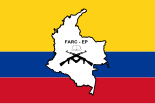
Revolutionary Armed Forces of Colombia
The Revolutionary Armed Forces of Colombia – People's Army (Spanish: Fuerzas Armadas Revolucionarias de Colombia – Ejército del Pueblo, FARC–EP or FARC) is a Marxist–Leninist guerrilla group[14] involved in the continuing Colombian conflict starting in 1964. The FARC-EP was officially founded in 1966 from peasant self-defense groups formed from 1948 during the "Violencia" as a peasant force promoting a political line of agrarianism and anti-imperialism. They are known to employ a variety of military tactics,[15] in addition to more unconventional methods, including terrorism.[16][17][18][19]
"FARC" redirects here. For the political party formed by former members of this organization, see Common Alternative Revolutionary Force.Revolutionary Armed Forces of Colombia – People's Army
1964–2016
- militarily dissolved as of 2017
- FARC dissidents still active
- Casa Verde (1965–1990)
- Los Pozos[1]
The operations of the FARC–EP were funded by kidnap and ransom, illegal mining,[20] extortion, and taxation of various forms of economic activity, and the production and distribution of illegal drugs.[21][22] They are only one actor in a complex conflict where atrocities have been committed by the state, right-wing paramilitaries, and left-wing guerrillas not limited to FARC, such as ELN, M-19, and others. Colombia's National Centre for Historical Memory, a government agency, has estimated that between 1981 and 2012 paramilitary groups have caused 38.4% of the civilian deaths, while the Guerillas are responsible for 16.8%, the Colombian Security Forces for 10.1%, and other non-identified armed groups for 27.7%.[23] The National Centre for Historical Memory has also concluded that of the 27,023 kidnappings carried out between 1970 and 2010, the Guerillas were responsible for 90.6% of them.[23] The United Nations has estimated that 12% of all civilian deaths in the Colombian conflict were caused by FARC and National Liberation Army (ELN) guerrillas, with 80% caused by right-wing paramilitaries, and the remaining 8% caused by Colombian security forces.[24]
The strength of the FARC–EP forces was high; in 2007, the FARC said they were an armed force of 18,000 men and women; in 2010, the Colombian military calculated that FARC forces consisted of about 13,800 members, 50 percent of whom were armed guerrilla combatants; and in 2011 the president of Colombia, Juan Manuel Santos, said that FARC–EP forces comprised fewer than 10,000 members. The Colombian Ministry of Defense reported 19,504 deserters, or individually demobilized members, from the FARC between August 2002 and their collective demobilization in 2017,[25] despite potentially severe punishment, including execution, for attempted desertion in the FARC.[26]
FARC made 239 attacks on the energy infrastructure; however, they showed signs of fatigue. By 2014, the FARC were not seeking to engage in outright combat with the army, instead concentrating on small-scale ambushes against isolated army units. Meanwhile, from 2008 to 2017, the FARC opted to attack police patrols with home-made mortars, sniper rifles, and explosives, as they were not considered strong enough to engage police units directly. This followed the trend of the 1990s during the strengthening of Colombian government forces.[27]
In June 2016, the FARC signed a ceasefire accord with the President of Colombia, Juan Manuel Santos in Havana. This accord was seen as an historic step to ending the war that has gone on for fifty years.[28] On 25 August 2016, the Colombian president, Juan Manuel Santos, announced that four years of negotiation had secured a peace deal with FARC and that a national referendum would take place on 2 October.[29] The referendum failed with 50.24% voting against.[30] On November 24, 2016, the Colombian government and the FARC signed a revised peace deal,[31] which the Colombian Congress approved on 30 November.[32]
On 27 June 2017, FARC ceased to be an armed group, disarming itself and handing over its weapons to the United Nations. One month later, FARC announced its reformation as a legal political party, in accordance with the terms of the peace deal.[33] However, about 2,000 to 2,500 FARC dissidents still take on FARC's original doctrine and continue with drug trafficking, though far smaller than the group at its peak.[34]
A small faction of FARC leaders announced a return to armed activity on 29 August 2019, stating that the Colombian government did not respect peace agreements, a position Colombian officials disagreed with.[12][35] The Colombian government responded with preemptive strikes, killing FARC members planning to lead rearmament activities.[36] In October of 2023, the Colombian government engaged in peace talks with the FARC splinter group and agreed to a ceasefire. In January, both sides agreed to extend the ceasefire to June 2024.[37]
As of February 2024, the vast majority of former FARC members have honored the 2016 peace agreement.[38]
International response[edit]
The FARC were a violent non-state actor (VNSA) whose formal recognition as legitimate belligerent forces is disputed by some organizations. As such, the FARC has been classified as a terrorist organization by the governments of Colombia, (since 1997) the United States[330] (until 2021), Canada,[331] Chile, (since 2010) New Zealand,[332] and (until 2016) the European Union;[333] whereas the governments of Venezuela (Maduro-led government), Brazil, Argentina, Ecuador, and Nicaragua do not. In 2008, Venezuelan President Hugo Chávez recognized the FARC–EP as a proper army. President Chávez also asked the Colombian government and their allies to recognize the FARC as a belligerent force, arguing that such political recognition would oblige the FARC to forgo kidnapping and terrorism as methods of civil war and to abide by the Geneva Convention. Juan Manuel Santos followed a middle path by recognizing in 2011 that there is an "armed conflict" in Colombia although his predecessor, Álvaro Uribe, strongly disagreed.[334]
The FARC built a deep relationship with the Gaddafi government in Libya, throughout the 1990s and 2000s until the latter's overthrow in 2011. The FARC in 2000 requested a $100 million loan from Tripoli, FARC commanders were hosted in Libya and FARC soldiers were allegedly seen fighting for Gaddafi in the First Libyan Civil War.[335][336][337][338]
